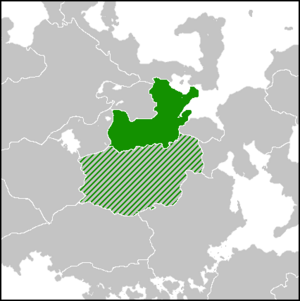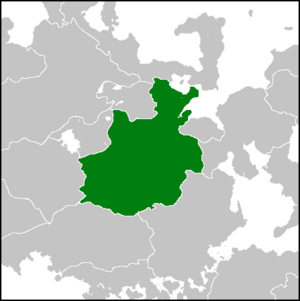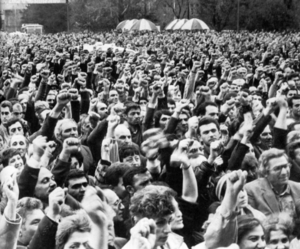Arsyan Republic
Gabrielt and Arsyan Republic 1976-1977 Dzukana i Arshanona Galorul (Gabrielt) Dkūnon Šaršōhnne Almditta (Arsyan) Arsyan Republic 1977-1985 Arshanona Galorul (Gabrielt) Šaršōhnne Almditta (Arsyan) | |||||||||
|---|---|---|---|---|---|---|---|---|---|
| 1976–1985 | |||||||||
|
Flag | |||||||||
| Motto: Kvi Gālen, Čen Mzol Two bodies, one soul | |||||||||
| Anthem: Žurrnni Kveh The Last Prayer | |||||||||
 Controlled areas (in green) and claimed areas (partially shaded) (1976-1980) | |||||||||
 Arsyan Republic (1980-1985) | |||||||||
| Capital | Sangur | ||||||||
| Common languages | Gabrielt Arsyan | ||||||||
| President | |||||||||
• 1976-1980 | Nyrina Tavan | ||||||||
• 1980-1985 | Oklom Timan | ||||||||
| Chancellor | |||||||||
• 1976-1981 | Kohmmi Tolore | ||||||||
• 1981-1985 | Bilir Tamva | ||||||||
| Legislature | People's Consultative Assembly | ||||||||
| House of Elders | |||||||||
| House of the People | |||||||||
| History | |||||||||
• Exile of Government | 12 February 1976 | ||||||||
• Established | 14 February 1976 | ||||||||
• Vehnnti talks | 7 February 1980 | ||||||||
• Amendment in effect | 1 March 1985 | ||||||||
• Disestablished | 1 March 1985 | ||||||||
| Area | |||||||||
| 1976 | 463,719 km2 (179,043 sq mi) | ||||||||
| 1980 | 468,194 km2 (180,771 sq mi) | ||||||||
| 1985 | 1,877,043 km2 (724,730 sq mi) | ||||||||
| Population | |||||||||
• 1976 | 24,100,847 | ||||||||
• 1980 | 25,871,105 | ||||||||
• 1985 | 79,439,105 | ||||||||
| Currency | Lirtta | ||||||||
| |||||||||
The Arsyan Republic, more officially known as the Gabrielt and Arsyan Republic until 1977, was a soveriegn state which encompassed the realms of Arsya and the northern portion of the New Frontier established after the fall of Vailhims to Dzakwanist forces on the 14th of February 1976. The Arsyan Republic maintained widespread international recognition from other nations, and was considered to legally own all of the territory of the former Gabrielt and Arsyan Republic (1930-1976) with the southern half mainly controlled and administered seperately under Dzakwanist Gabrielland. The Gabrielt and Arsyan goverment elected in 1975 was forced into exile into Sangur, where they declared a state of exile within their own homeland and continued to perform their duties.
The territories under the Arsyan Republic were considered "liberated territories" by the exiled government and most of the international community, while areas under Dzakwanist Gabrielland were considered occupied territories. The exiled Gabrielt government still claimed legitimacy over Dzakwanist Gabrielland, and treated the occupied territories as its southern regions. During this period, the democratically elected Gabrielt government in exile held snap elections in 1977 under the first and only elections within the Arsyan Republic. More liberal reforms and modernization within the Arsyan Republic in 1978 and 1979 dwarfed the Dzakwanists' economy, even with half the population.
The Arsyan Republic continues to maintain international recognition from the majority of foreign nations, with many moving their embassies to Sangur, however, some countries still maintained their embassies in Vailhims in secrecy although recognizing the country to be de jure part of the Arsyan Republic. The Arsyan Republic is considered by most modern Gabrielt historians to be the sole successor of the Gabrielt state. Since the territory of the new republic was almost exclusively located within Arsyan traditional lands and inhabited mostly by Arsyans, the new exiled Gabrielt government embraced pan-Arsyanism as a national basis during this time of need to compete with the nationalist movement in Gabrielland, and adopted new symbols to further reflect the change, although keeping the flag and emblem. The name was formally changed to just the "Arsyan Republic" on the 1st of January 1977, a name retained until 1984 even after reunification, the national anthem was changed to The Last Prayer, and the motto was changed to the one used in Arsya before the unification. These symbols were kept even after reunification with Gabrielland, as late as 1985.
On the 11th of February 1980, the 4th anniversary of the Dzakwanist takeover, the former government in exile was allowed to return to Vailhims and resume parliamentary and executive duties as normal, ceding the territory in and around Vailhims to the Arsyan Republic. On the 1st of May 1980, the Arsyan Republic was absorbed Dzakwanist Gabrielland into the Federation, and adopted a temporary constitution. Talks began discussing constitutional amendments, which was agreed on in 1983. The amendments took effect on the 1st of March 1985, and the Arsyan Republic changed its name to the Federation of Gabrielland and Arsya.
Context
The staged coup in Vailhims had triggered the formation of Dzakwanist Gabrielland, marking the fall of the Gabrielt and Arsyan Republic. Arsya, which was seen as a safe space from PDP sympathizers and elites was a popular destination for high-ranking politicians and officials of the previous government to go to, and many did before the military now already loyal to the PDP could seize their homes and the national parliament. The coup attempt in Gabrielland had succeeded, but had failed in Arsya due to a lack of support from the population and military. The current legitimate government, now with a majority in Sangur, Arsya, proclaimed an illegal occupation of Gabrielland by the PDP and declared a government-in-exile of the Gabrielt and Arsyan Republic three days after the coup in Vailhims. The new government-in-exile would then reproclaim and reinstate the continuation of the Gabrielt and Arsyan Republic on the 17th of February 1976 as a measure to ensure the international community the continued existence of a legitimate Gabrielt and Arsyan Government.
The fierecly anti-PDP population of Arsya enabled and eased the government in exile, which was comprised of mostly Gabrielts, to rule an exclusively Arsyan populace. By winter of 1976, there have been talks by the government in exile to stop addressing the current government as a government in exile, but a legitimate government of a sovereign nation. It was agreed to rename the Gabrielt and Arsyan republic into only the Arsyan Republic in a move to gain more sympathy from the Arsyan people in general and as a rebranding of the current government to disassociate themselves with the past government now in bad reputation in the eyes of the international community. On the 1st of January, the changes were officially made, and various national symbols were altered to focus solely on the Arsyan people, such as bringing back the Lirtta as the currency, returning the national anthem of the Kingdom of Arsya as well as its motto. Early elections were held in February 1977 and would be the only election to be solely held within Arsya only. Seeing the rapid changes in government, Mariyan Galli and the PDP agreed to recognize the Arsyan Republic as a legitimate sovereign state, although the PDP still claimed a huge portion of the republic's territory.
The Arsyan Republic in modern contexts is seen as the last bastion of democracy in Gabrielland and a dark period in Gabrielt history when the nation was divided into two. The renaming of the Gabrielt and Arsyan Republic into just the Arsyan Republic even after reunification is possibly one of the biggest controversies expressed by a bigger element of society, with many implying that the delayed name change was a way of explicitly showcasing Arsyan hegemony over the Gabrielt nation, however is refuted by historical and law experts, citing the state of Gabrielland at that time and the need for international recognition and assistance is more important than just the name itself.



